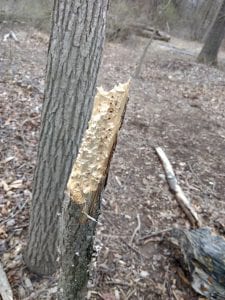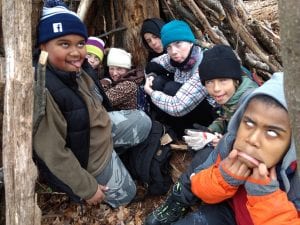4/3/2018
Spring has arrived and with Spring come the birds! Last class we learned about why people study and watch birds, how to identify birds and also how to sketch birds. We also got to build really cool paper airplanes of various designs and test them in the field! This week was all about bird surveying and learning a few new cool technological advances inspired by birds and another animal, too. Upon walking to our afternoon circle spot we bumped into a really interesting tree that had been broken off at waist height and had been chipped away at. Some of us thought it might have been a beaver because it definitely looked like a beaver had been gnawing away, but upon closer inspection, you can see the small holes in the wood. This was done by some type of woodpecker! (Check it out below). This is a great example of a sign that an animal has left behind and just from this clue we can learn a lot about that animal, for example, what animal was here, what wood they were pecking at, the size of the holes they made, was the tree recently dead or was it alive at the time, etc.
At our story circle we discussed what our plans were for class that day and then headed over to the aviary to collect some containers of bird seed. Along the Vista Loop Trail at Irvine there are two Wildlife Blinds, which are perfect bird viewing spots. We were hoping to attract some birds to us by filling up the feeders. At the aviary we checked in on our non releasable birds of prey and were excited to see the Great Horned Owl out of her box and curious to see us. Once we arrived at the first Wildlife Blind we noticed that there was a lot of bird activity! We quickly sat down, pulled out of surveying sheet, some binoculars and the bird guides and started counting birds. We used a Great Backyard Bird Count Data Form (available at the link below) because it had the basics that you want to record when recording birds.
http://gbbc.birdcount.org/wp-content/uploads/2016/11/Evergreen_GBBC_DataForm_English.pdf
There are far more advanced bird surveying sheets used by ornithologists that record the bird by their code names. For example, Great Horned Owl’s code name is GHO. Ornithologists (scientists that study birds) also will record the direction they saw/heard the bird, how long the call/song lasted, approximately how far away it was, if it was male/female (if they could see the bird), etc. Today we were just recording our location, the day we made our list, the time we started, whether we were reporting all the species we saw or not, how many people were reporting and how long the observation lasted.
Here is what we recorded and what species we saw and how many individuals:
Location: Irvine Wildlife Blind #1, Observation Date: Tuesday April 3rd 2018, Count Start Time: 1:42 pm, Total Time: 15 minutes, We are reporting every species we saw, How Many People Participating in the Reporting? 10.
Species Reported and Number:
White-breasted Nuthatch: 3, Tufted Titmouse: 2, Carolina Chickadee: 2, Dark-eyed Junco: 1, White-throated Sparrow: 5, Northern Cardinal: 2, Mourning Dove: 1, Downy Woodpecker: 1, Red-winged Blackbird: 1
We also took note of the weather conditions, it was cold, about 42 degrees, with a slight drizzle and very cloudy.
While we were watching birds at the blind we also discussed what the birds were doing, where we saw them, and noted some of their actions. For example, all the sparrows stayed low to the ground and never came up to a feeder, the red-winged blackbird landed high in a tree and also never visited the feeder. We were careful to watch the tufted titmouse birds, chickadees and nuthatches because they returned to the feeder numerous times, so we didn’t want to recount individuals. The woodpecker stayed far away from the feeder and there were a lot of birds making loud calls and flying around at each other, likely having territorial disputes. To avoid recounting birds we counted the total number of each species we saw at one time. We also practiced using the binoculars and using the basic bird guides in the wildlife blind. Another tool we checked out was the Merlin Bird App. This is a fantastic tool for helping anyone of any skill level identify birds. It asks you very simple questions: your location, the date, and on a visual scale the size of your bird, the three most prominent colors you saw on the bird and then it generates a list of likely species. The following is another website resource that can provide some usual information on monitoring birds and how you can get involved! There are fantastic citizen science websites such as ebird and Project Feeder Watch, that allow you to record birds you see and help scientists monitor their populations. I have provided some links below:
https://marylandbirds.org/iba-monitoring-project/
https://ebird.org/home
https://feederwatch.org/
After watching the birds eat, we were hungry so it was time to head to the Gazebo for snack. During snack we also shared anything excited that happened over the last couple of weeks. Both Solace and James and Eva found Black Rat Snakes in their houses! Snakes hibernate over the winter (it’s called brumation in snakes) and they like to find warm, dark places to wait out the winter. They will wake up during the winter to feed occasionally and move around, which is why it isn’t a true hibernation. What a cool discovery! After snack we explored an A-Frame wood structure built by another homeschool class and then continued down the trail to our favorite spot, the climbing tree.
We tiding up the tree and added some more branches and grass to the nest as the rain started to fall a bit harder. Once our hands were too chilly and we were getting too wet it was time to seek shelter. We walked through the meadow and watched a lot of American Robins hopping through the grass looking for bugs and worms and stopped at the Ed Hut. We introduced some fun riddles that we plan to revisit next week and then made our way to the Wildlife Blind, the rain really falling now along with the temperature. We quickly filled up the feeders and then huddled in the blind. We noted that the weather was colder and rainier than the previous wildlife blind and we also noticed there were fewer birds (even though there are usually a lot here) . Here is our report (the date, number of people participating in the reporting and recording all the species we saw stayed the same).
Location: Irvine Wildlife Blind #2, Count Start Time: 3:25pm, Total Time: 5 minutes. Here are the species we saw and recorded:
Carolina Chickadee: 2, Tufted Titmouse: 2, White-throated Sparrows: 5
Each wildlife blind has a different type of habitat. The first blind is forested with the most dominate tree being tulip poplar. The second wildlife blind is on an edge habitat (which means it sits on the edge of two different types of habitats) and the two types of habitats are forest and meadow. Generally edge habitats have a lot more species because species will overlap in these habitats and there is more variety, but the weather likely influenced the number and types of birds we saw today. With the rain falling and the cold setting in, we headed in for the last 20 minutes of class. Inside, we reviewed some new biomimicry concepts and learned about two animals, the owl and the shark, and how they inspired technology. Owl feathers are special because the edges of the feathers are soft, instead of ridged, which helps break up the sound of air as it passes over the feather, allowing for silent flight. In fall we learned about humpback whale fins that inspired wind turbine blades to be more efficient because the bumpy edge helps break up the flow of water as it passes over the fin creating less resistance. Well owl feathers do something similar but with air. This is inspiring a lot of technology with fan blades, trying to create quieter fans of all sizes. Shark skin is like sand paper and under magnification it looks like scales. Wet suits and other swim gear has been designed to allow the swimmer to swim through the water faster and with less resistance.
We finished the day by using story cubes to write a story inspired by Irvine’s Great Horned Owl. Each person got a dice to roll and created one sentence for the story based on the picture on the dice. Here is what we wrote:
“Once there was a mammoth and a great horned owl playing Quidditch. A cow came along and joined in. But he was so vane looking in his mirror that he kicked over a bottle of poison. A raccoon came along and thought it was lemonade and drank it. The raccoon then went to jail because he drank the lemonade without paying for it. A triceratops ran the jail and broke out the mammoth, the owl and the cow who went to jail with the raccoon. They were all so happy to be out of jail they played the flute. But they were being searched for so they found a place to hide in a kid’s tree house. The kid had an acid volcano in the tree house and when the mammoth swung his tail he hit the button and the volcano exploded and the great horned owl was the only one that escaped.” The end!




